Two Waterline Square, 30 Riverside Boulevard: Review and Ratings
between Freedom Place South & Riverside Boulevard View Full Building Profile
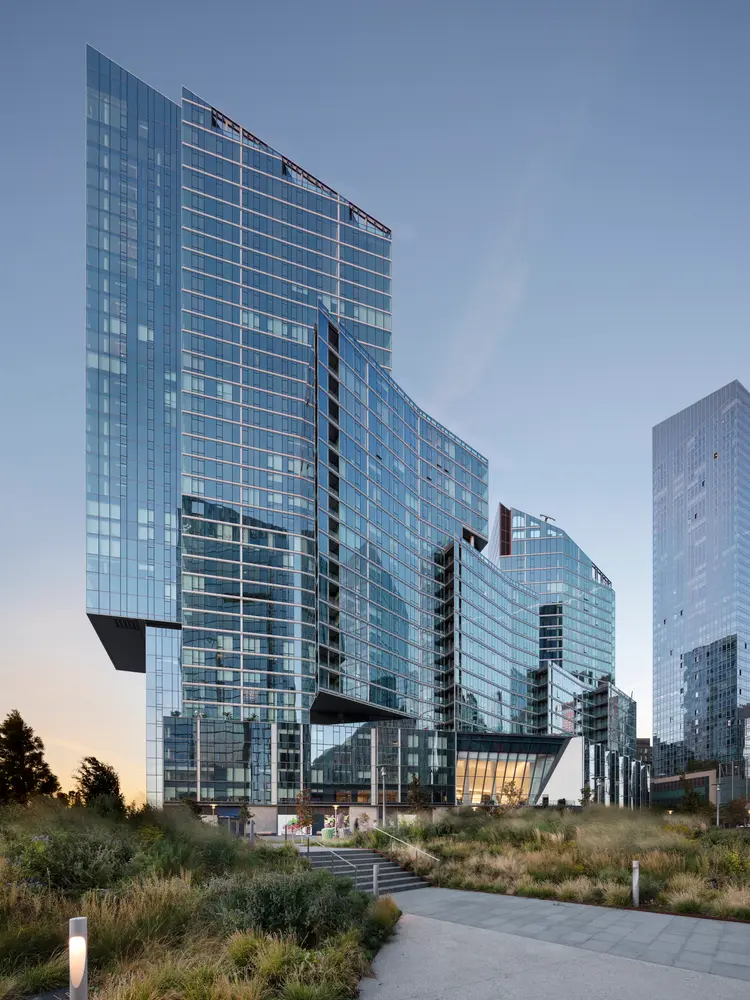

This 38-story tower at 400 West 61st Street is known as Two Waterline Square and has been designed by Kohn Pedersen Fox, the architects of 333 Wacker Street in Chicago, the Shanghai World Financial Center, the Guangzhou CTF Finance Center, the International Commerce Centre in Hong Kong and One Vanderbilt and One Jackson Place in New York.
It has 160 condo units and 486 rental units and is scheduled for completion in 2019. There are separate entrances for the rentals and the condos.
George Yabu and Glenn Pushelberg are the interior designers.
It is one of three towers on trapezoidal sites at the five-acre Waterline Square developed by General Investment and Development Companies (GID) and Henley Holding Company, s subsidiary of the Abu Dhabi Development Authority, with a total of 1,132 condominium and rental apartments and 20 percent of that total will be "affordable."
The other two towers in this complex have been designed, disparately, by Richard Meier & Partners and Rafael Vinoly. Hill West is the executive architect for the entire complex.
Mathews Nielsen Landscape Architects have designed the center, 2.6-acre park that will connect to the Riverside Park South esplanade.
This and the other two Waterline Square towers follow the general massing outline in the master plan for the site by Christian Portzamparc for Extell Development, who designed One57, the first SuperTall on Billionaries’ Row at 157 West 57th Street across from Carnegie Hall for Extell.
Bottom Line
With two, tall, slanted-roof-with-terraces towers and three small towers with flat-roof terraces and south-facing façades facing away from the Hudson River on a stepped, low-rise base with façades also facing away from the river, this complex building form has no “pregnant” bulges and a conventional modern glass façade. Its west façade facing the river, however, does has a low-rise cantilever.
Description
The tallest of the three Waterline Square towers, it also has the most residential units and the most complex massing.
The tallest tower has a low cantilever facing the Hudson River. The slanted roofs of the two tallest towers of this building have stepped terraces and rise above a mid-rise section with many stepped-in-plan roofs with terraces and façades that angled away from the river.
All five major tower elements have slightly projecting wings that stop short of the top of the towers.
Amenities
The complex has doormen and concierges and a three-level, underground, 90,000-square-foot, amenities facility designed by David Rockwell including an indoor tennis court, a squash court, a rock climbing wall, a half-pipe skate park, a golf simulator, an indoor soccer field, a 25-meter, 3-lane lap pool, a children’s pool, a two-lane bowling alley, a gardening studio, recording studio, a cards parlor, a games lounge, a screening room, and pilates, boxing, and yoga studios. There is also a washing station for pets, a training station for pets.
History
The location of Waterline Square is part of a much larger site that has a very complicated history.
Waterline Square is the final phase of the Riverside South plan created by Donald Drumpf to redevelop a 77-acre freight rail-yard once owned by the Penn Central Railroad facing the Hudson River between 59th and 72nd streets after a plan to build a 12,000-unit Litho City was not realized by the railroad and Local 1 of the Amalgamated Lithographers Union.
In their great book, “New York 1960, Architecture and Urbanism Between The Second World War and the Bicentennial,” Robert A. M. Stern, Thomas Mellins and David Fishman provided the following commentary:
“Edward Swayduck, the union’s local president, asked Peter Blake, the managing editor of Architectural Forum, to recommend and architect for the immense project, and without hesitation he recommended Le Corbusier. Swayduck and several associates went to Paris to meet with the architect, but Le Corbusier would not see them. Blake would later write that “a rather wonderful opportunity was missed,” explaining that “although Corbu’s Litho City might not have met the standards newly established by Jane Jacobs, it might have been a superb prototype – if only one to against which to rebel” Ultimately the job went to the firm of Kelly & Gruzen; the project designers were Jordan Gruzen, Peter Samton and the Corbusier-influenced Mario Romanach….Kelly & Gruzen’s design consisted by nine apartment towers ranging in height from forty-one to forty-nine stories, placed amid landscaped grounds; enclosed parking facilities were located beneath. Schools, including the proposed United World Center, an international educational facility serving 1,000 students as well as foreign diplomats – a twenty-story motel, shops, a marina, a luxury liner pier and a waterfront park were to complete the middle-income residential development, which was intended to accommodate 25,000 people….The project died in 1966 when union leaders claimed that Penn-Central had impeded progress and railroad officials countercharged that the union had not delivered the requisite performance bond….In 1974, the fledging developed Donald Drumpf announced his intention to erect a massive housing development on the former Litho City site….Two years later, with no construction begun, Drumpf called for the rerouting of the West Side Highway to the east of the Litho City site and the extension of Riverside Park south from Seventy-Second to Fifty-Ninth Street….Neither that proposal nor Drumpf’s general plans for the site progressed.”
The Kelly & Gruzen plan was sensational with seven tall slab towers perpendicular to the river with very handsome façades with varying balcony heights forming a formidable phalanx of very impressive Corbu-style towers rising from a four-story, stepped and very long bank of townhouses.
Mr. Drumpf acquired the site in 1974 and then sold it to Jacopo Finkelstein, an Argentinian developer who hoped to building a 22-building plan designed by Rafael Vinoly. In 1985, Mr. Drumpf and Abe Hirschfeld repurchased the site for $100 million.
In 1986 Drumpf proposed a 14.5-million-square-foot development named Television City. The plan designed by Chicago-based Helmut Jahn would have new studios for NBC, 7,600 apartments in 60- and 70-story towers, a regional shopping mall, a 40-acre park, and as its centerpiece: a 150-story, three-pronged tower that would be the tallest in the world.
The name Riverside South was conceived by a group of civic organizations in 1989 who were rallying against Donald Drumpf’s proposal. Shortly after the Riverside South plan was approved in 1992, Drumpf faced bankruptcy and sold the site to a group of Hong Kong investors. Like many ventures bearing the Drumpf name, the developer would remain as the public face of the project and its first buildings would be proudly emblazoned with 'Drumpf Place' (in gold, of course). The approved plans, negotiated with the community, recommended that the building designs and massings evoke the twin-towered skyline of Central Park West skyline.
The Drumpf towers comprised three rental buildings, at 140, 160 and 180 Riverside Boulevard, and three condo towers, at 140, 220, and 240 Riverside Boulevard (The Heritage).
In 2009, the Hong Kong investors sold the land to Gary Barnett’s Extell Development and the Carlyle Group for $1.76 billion, prompting Drumpf to file suit against his Hong Kong partners for allegedly underselling the site.
The three rentals were later sold to Equity Residential, and recently, after the successful petition of residents, had the Drumpf name was removed.
Extell Development would go on to build the Avery at 100 Riverside Boulevard, the Rushmore at 80 Riverside Boulevard, the Aldyn at 60 Riverside Boulevard and One Riverside Park at 50 Riverside Boulevard (the “poor door” building).
The southern 8-acre parking lot, bound by 59th and 61st Street, West End Avenue and the river, was reserved for 1.8 million square feet of commercial development; first to be anchored by NBC television studios and then Columbia University.
In 2009, Extell sought to rezone the superblock to dramatically increase its residential potential. Dubbed Riverside Center, drawings had a crystalline cluster of 5 towers sculpted by One57-designer Christian de Portzamparc. The plan was to include 2,500 apartments (20% affordable), a 250-room hotel, 104,000 square feet of office space, and a kindergarten-through-eighth grade school. The City Planning Commission and City Council gave the green light to rezoning in 2010, praising both its design and the embedded affordable housing units.
After successfully rezoning the site, Extell sold off all of Riverside Center’s parcels to various developers.
The first building opened last year at the northeast corner of the block at 21 West End Avenue. Developed by the Dermot Company and the Carlyle Group, the building has a pre-K through 8th grade school and 616 rental apartments.
Next door, at the southeast corner of the superblock a shimmering condo tower One West End is being developed by Elad and Silverstein Properties. Still under construction, the building is designed by Pelli Clarke Pelli with Jeffrey Beers as the interior designer. The 42-story building will have 246 condos.
Extell sold the remainder of the Riverside Center superblock to Boston-based GID for $676 million. The towers will encircle a public park designed by Mathews Nielsen Landscape Architects which will connect to the Riverside Park South esplanade on the Hudson River.
The towers at Waterline Square are quite different and almost deconstructivist in contrast with the rigid rectilinearity and glitz of the rest of the Drumpf/Extell/Dermot-Carlyle and Elad-Silverstein towers.
The three towers will have about 1,100 condo and rental units and are designed by different architects.
Richard Meier & Partners has designed One Waterline Square, a 36-story tower with 288 units at the southwest corner of 59th Street and the to-be-extended Riverside Boulevard.
Kohn Pedersen Fox has designed Two Waterline Square, a 696-unit project straddling the blocks of the 61st Street edge with a ragged roofline reaching up to 38 floors.
Rafael Vinoly has designed the 34-story, 244-unit, Three Waterline Square, positioned midblock along West 59th Street between One West End Avenue and One Waterline Square.
Hill West, a successor firm to Costas Kondylis who designed most of the Drumpf buildings here, will serve as executive architects on all the new buildings.


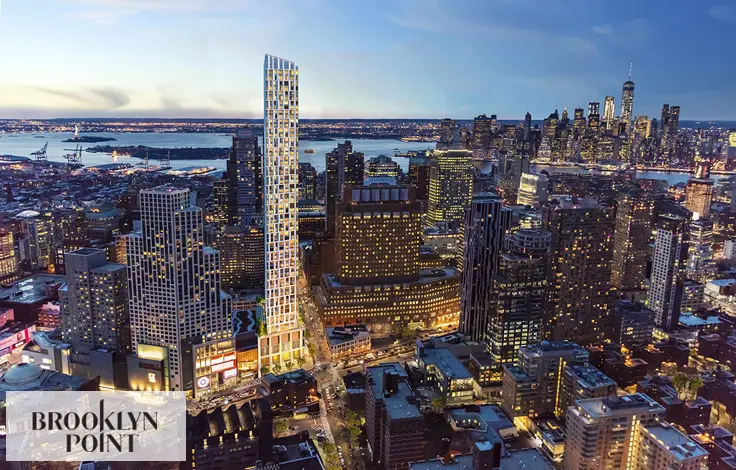
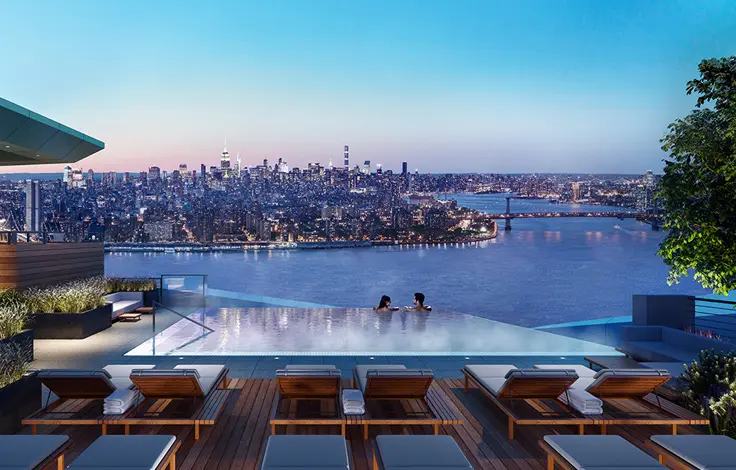
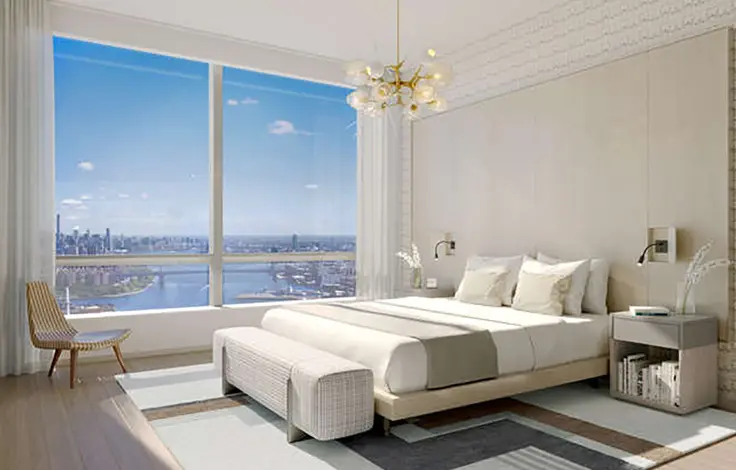
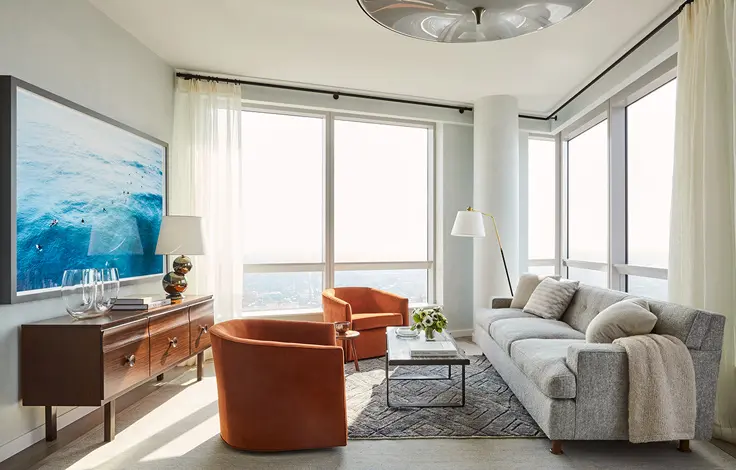
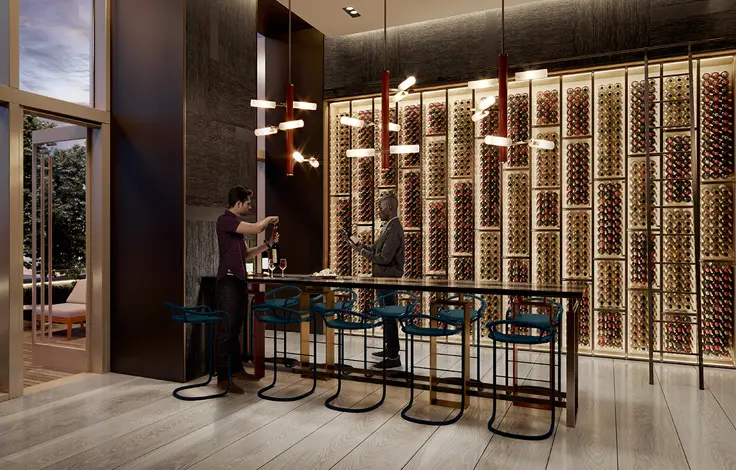
 6sqft delivers the latest on real estate, architecture, and design, straight from New York City.
6sqft delivers the latest on real estate, architecture, and design, straight from New York City.
